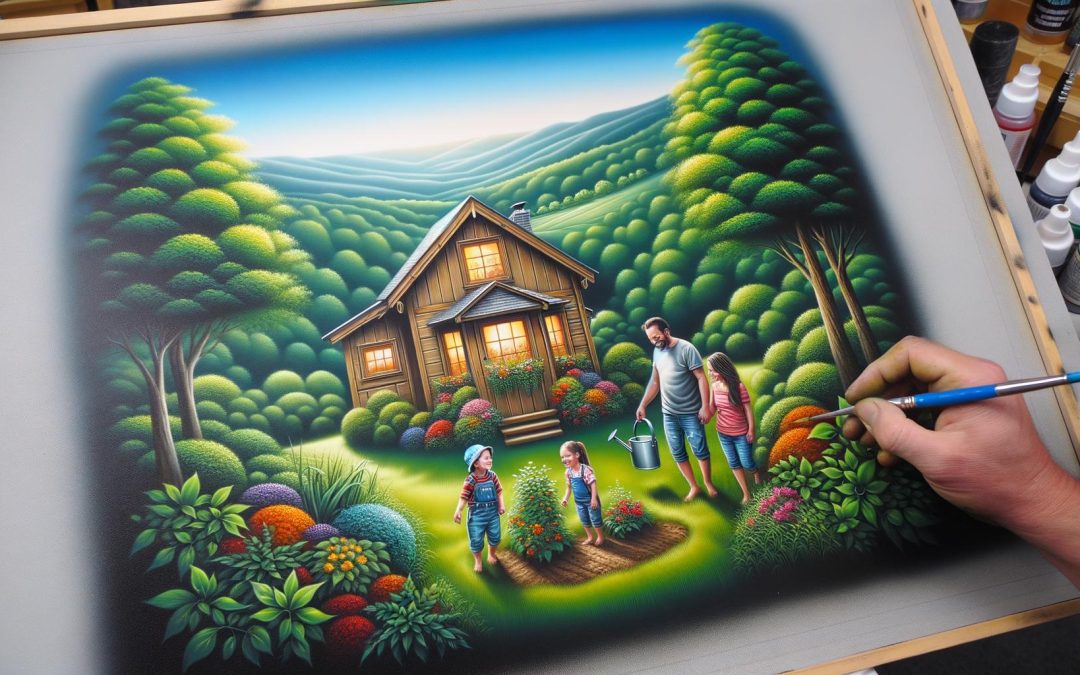At Outbuilders, we’ve seen a growing interest in the tiny home movement. But what exactly is the meaning of a tiny home?
These compact dwellings are reshaping how people think about housing and lifestyle choices. In this post, we’ll explore the essence of tiny homes, their benefits, and the challenges they present.
What Defines a Tiny Home?
The tiny home movement has gained significant traction in recent years, particularly in areas like Central Oregon. But what exactly constitutes a tiny home?
Size and Philosophy
A tiny home is a residential structure under 400 square feet. This compact size contrasts sharply with the average American home, which the U.S. Census Bureau reports as 2,261 square feet as of 2020. The philosophy behind tiny homes centers on life simplification, environmental impact reduction, and financial freedom achievement.
The Origins of Tiny Living
The concept of tiny homes isn’t new. Throughout history, people lived in small dwellings out of necessity or choice. However, the modern tiny house movement gained momentum in the late 1990s, partly as a response to the housing market crash and growing environmental concerns.
Sarah Susanka’s 1998 book “The Not So Big House” often receives credit for kickstarting the movement. It challenged the notion that bigger always means better in housing. This idea resonated with many Americans who sought alternatives to traditional homeownership and its associated costs.
Key Features of Tiny Homes
Tiny homes incorporate clever design elements to maximize space efficiency. Multi-functional furniture, loft sleeping areas, and innovative storage solutions are common features. For example, stairs often double as storage units, and tables may fold away when not in use.

Energy efficiency is another hallmark of tiny homes. Many utilize solar panels, composting toilets, and rainwater collection systems. These features not only reduce utility costs but also minimize environmental impact. A study by Maria Saxton (published in the Journal of Environmental Psychology) found that people who downsized to tiny homes reduced their energy consumption by 45% on average.
Tiny Homes vs. Traditional Houses
The most obvious difference between tiny and traditional homes is size. But the distinctions go beyond square footage. Tiny homes often prioritize quality over quantity, featuring high-end finishes and custom designs in a small package.
Financially, tiny homes offer a path to homeownership with significantly lower costs. While the median sales price of a single-family U.S. home was $428,700 as of the first quarter of 2022, a tiny home can cost anywhere from $30,000 to $60,000, depending on customization.
Mobility is another key difference. Many tiny homes are built on trailers, which allows owners to relocate as desired. This flexibility appeals particularly to young professionals and retirees who seek adventure.
However, it’s important to note that tiny living isn’t for everyone. It requires a significant lifestyle adjustment and willingness to live with less. Potential tiny home dwellers should carefully consider their needs and preferences before they make the leap.
As we explore the benefits of living in a tiny home in the next section, you’ll discover why more people are embracing this alternative lifestyle.
Why Tiny Homes Make Sense
Financial Freedom Through Downsizing
Tiny homes slash living costs dramatically. The average price of a tiny home is $67,000, which is 87% cheaper than the average price of a normal-sized house. This stark difference enables many to own a home outright, eliminating mortgage payments.

Utility bills also shrink in tiny homes. The American Tiny House Association reports that tiny home dwellers save 36-59% on energy compared to traditional homeowners. Some tiny home owners boast monthly utility bills as low as $25 (an impressive feat in today’s energy market).
Eco-Friendly Living Made Easy
Tiny homes leave a smaller environmental footprint. A study by Maria Saxton revealed that tiny home residents reduced their energy consumption by 45% on average. The compact space requires less heating, cooling, and lighting, naturally cutting energy use.
Many tiny homes incorporate eco-friendly features such as solar panels, composting toilets, and rainwater collection systems. These additions further reduce environmental impact and often lead to even greater cost savings (a win-win for both the planet and the wallet).
Embracing Minimalism and Experiences
Tiny living prompts a reevaluation of possessions. It’s not about deprivation, but about prioritizing what truly matters. Many tiny home dwellers report feeling liberated after downsizing, shifting their focus from material goods to experiences.
This shift often improves mental health. Previous qualitative research has identified seven motivations for tiny home living, including financial and environmental concerns.
Flexibility in an Ever-Changing World
Tiny homes, especially those on wheels, offer unparalleled flexibility. This mobility appeals particularly in today’s dynamic job market. Relocating for work becomes simpler and less costly.
For retirees, a tiny home can provide a perfect solution for traveling while maintaining a home base. Some tiny home owners even use their properties as vacation rentals when they’re away, creating an additional income stream (turning their home into a potential money-maker).
While tiny living presents compelling benefits for those willing to embrace a simpler, more intentional lifestyle, it’s important to consider potential challenges. In the next section, we’ll explore some of the hurdles tiny home enthusiasts might face and how to overcome them.
Navigating the Challenges of Tiny Home Living
Zoning and Legal Hurdles
Zoning laws present a significant obstacle for many tiny home enthusiasts. In the United States, these regulations vary widely by location. Some areas welcome tiny homes, while others have strict minimum size requirements for permanent dwellings.

To overcome this maze, research local zoning laws thoroughly before you commit to a location. Many tiny home owners find success by classifying their homes as RVs or accessory dwelling units (ADUs). Some counties in Oregon allow tiny houses and tiny homes on wheels (THOWs) as accessory dwelling units (ADUs) in all residential zones.
Join tiny home communities or reach out to local tiny home associations. These groups often provide valuable insights into navigating local regulations and can offer support in dealing with authorities.
The Art of Downsizing
The transition to a tiny home requires ruthless decluttering. Start this process early (ideally months before your move). Begin with rarely used items and gradually work through your possessions.
Apply the “one in, one out” rule. For every new item you bring into your tiny home, remove one. This helps maintain a clutter-free space and encourages mindful consumption.
Invest in multi-functional furniture and clever storage solutions. Creative uses of space, like stairs that double as drawers or kitchen islands with built-in storage, can significantly increase your storage capacity without sacrificing living space.
Adapting to Compact Living
Living in a tiny home requires a mental shift. The transition can jar those used to spacious environments. To ease the adjustment, try a trial run. Rent a tiny home for a week or two to experience the lifestyle firsthand.
Maximize your outdoor space. A well-designed outdoor area can effectively extend your living space. Add a deck, patio, or even a small greenhouse to create additional functional areas.
Embrace vertical space. Install tall shelving units, use wall-mounted organizers, and explore overhead storage options. These strategies can free up valuable floor space and make your tiny home feel more open.
Building Code Compliance
Building codes can pose challenges for tiny home construction. These codes often specify minimum room sizes, ceiling heights, and other requirements that may not align with tiny home designs.
Work with experienced builders who understand local building codes and can help you navigate compliance issues. In some cases, you may need to seek variances or special permits to build your tiny home.
Consider prefab tiny homes or modular construction methods. These options often come pre-certified and can simplify the building code compliance process.
Utility Connections
Connecting utilities to a tiny home can be complex, especially for off-grid or mobile units. Water, electricity, and sewage systems require careful planning.
Explore alternative energy sources like solar panels or wind turbines for electricity. For water, consider rainwater collection systems or well water options. Composting toilets or incinerating toilets can solve waste management issues without the need for traditional sewage connections.
Final Thoughts
The tiny home movement represents a shift in how we view housing and lifestyle choices. These compact dwellings embody a philosophy of simplicity, sustainability, and financial freedom. The meaning of a tiny home extends beyond its size; it’s about intentional living and prioritizing experiences over possessions.

Tiny homes offer numerous benefits, from reduced living costs to a smaller environmental footprint. They provide a path to homeownership for many who might otherwise struggle in the traditional housing market. The flexibility and mobility of tiny homes also appeal to those seeking adventure or adapting to changing job markets.
For those in Central Oregon considering a tiny home or looking for high-quality storage solutions, Outbuilders offers a range of customizable options. Our expert team can help bring your vision to life with exceptional craftsmanship and personalized designs. Whether you choose to embrace tiny living fully or incorporate some of its principles into your current lifestyle, the tiny home movement offers valuable lessons about simplicity and sustainability.







Recent Comments